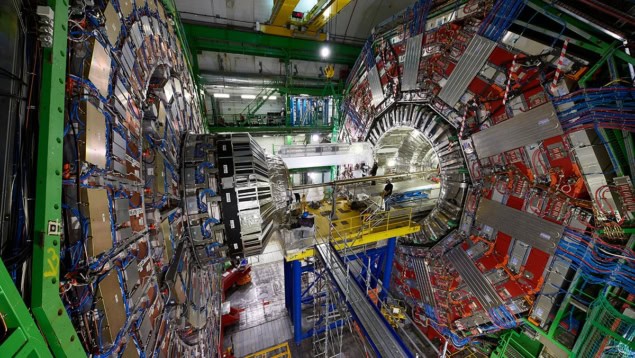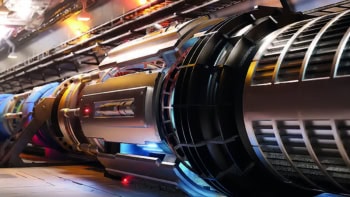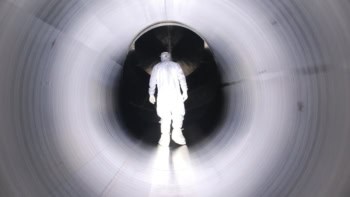
The speed of sound in a quark–gluon plasma has been measured by observing high-energy collisions between lead nuclei at CERN’s Large Hadron Collider. The work, by the CMS Collaboration, provides a highly precise test of lattice quantum chromodynamics (QCD), and could potentially inform neutron star physics.
The strong interaction – which binds quarks together inside hadrons – is the strongest force in the universe. Unlike the other forces, which become weaker as particles become further apart, its strength grows with increasing separation. What is more, when quarks gain enough energy to move apart, the space between them is filled with quark–antiquark pairs, making the physics ever-more complex as energies rise.
In the interior of a proton or neutron, the quarks and gluons (the particles that mediate the strong interaction) are very close together and effectively neutralize one another’s colour charge, leaving just a small perturbation that accounts for the residual strong interaction between protons and neutrons. At very high energies, however, the particles become deconfined, forming a hot, dense and yet almost viscosity-free fluid of quarks and gluons, all strongly interacting with one another. Calculations of this quark gluon plasma are non-perturbative, and other techniques are needed. The standard approach is lattice QCD.
Speed of sound is key
To check whether the predictions of lattice QCD are correct, the speed of sound is key. “The specific properties of quark–gluon plasma correspond to a specific value of how fast sound will propagate,” says CMS member Wei Li of Rice University in Texas. He says indirect measurements have provided constraints in the past, but the value has never been measured directly.
In the new work, the CMS researchers collided heavy ions of lead instead of protons because – like cannonballs compared with bullets – these are easier to accelerate to high energies and momenta. The CMS detector monitored the particles emitted in the collisions, using a two-stage detection system to determine what type of collisions had occurred and what particles had been produced in the collisions.
“We pick the collisions that were almost exactly head-on,” explains Li, “Those types of collisions are rare.” The energy is deposited into the plasma, heating it and leading to the creation of particles. The researchers monitored the energies and momenta of the particles emitted from different collisions to reconstruct the energy density of the plasma immediately after each collision. “We look at the variations between the different groups of events,” he explains. “The temperature of the plasma is tracked based on the energies of the particles that are coming out, because it’s a thermal source that emits particles.”
In this way, the researchers were able to measure the speed at which heat – and therefore energy density – flowed through the plasma. Under these extreme conditions, this is identical to the speed of sound i.e. the rate at which pressure travels. “In relativity, particle number is not conserved,” says Li; “You can turn particles into energy and energy into particles. But energy is conserved, so we always talk about total energy density.”
Even more stringent tests
The team’s findings matched the predictions of lattice QCD and the researchers would now like to conduct even more stringent tests. “We have extracted the speed of sound at one specific temperature,” says Li. “Whereas lattice QCD has predicted how the speed of sound goes with temperature as a continuous function. In principle, a more convincing case would be to measure at multiple temperatures and have them come out all agreeing with the lattice QCD prediction.” One remarkable prediction of lattice QCD is that, as the temperature of the quark–gluon plasma drops to its lowest possible temperature, the sound speed reaches a minimum before then increasing as the temperature drops further and the quarks become bound into hadrons. “It would be remarkable if we could observe that,” he says.

Mysterious X particle spotted in quark–gluon plasma at CERN
The research is described in a paper in Reports on Progress in Physics.
“I think it’s a good paper,” says nuclear theorist Larry McLerran of the University of Washington in Seattle – who is not a CMS member. He believes its most interesting aspect, however, is not what it shows about the theory being tested but what it demonstrates about the techniques used to test it. “The issue of sound velocity is interesting,” he says. “They have a way of calculating it – actually two ways of calculating it, one of which is kind of hand waving, but then it’s backed up with detailed simulation – and it agrees with lattice gauge theory calculations.”
McLerran is also interested in the potential to study heavy-ion collisions at low energies, and hopes these might give clues about the cold, dense matter in neutron stars. “In heavy ion collisions, you can calculate the sound velocity squared as a function of density using numerical methods, whereas these numerical methods don’t work at high density and low temperature, which is the limiting case for neutron stars. So being able to measure a simple bulk property of the matter and do it well is important.”
- The paper appears in IOP Publishing’s flagship journal, Reports on Progress in Physics, which now publishes original research.



